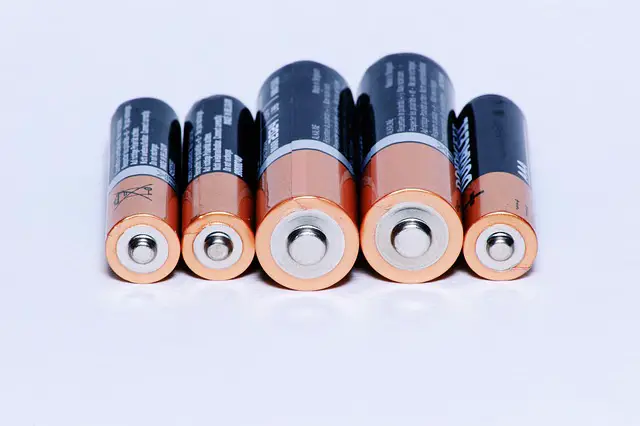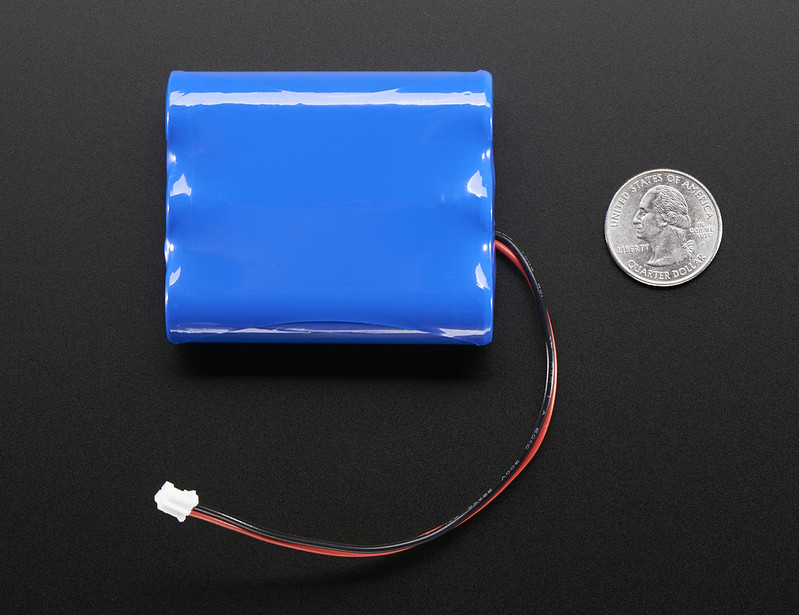Nickel Cadmium batteries last longer but can be difficult to recycle and can suffer from the memory effect. On the other hand, Lithium Ion batteries are more environmentally friendly and don’t suffer from the same issues as nickel cadmium cells however they may not provide quite as long of a charge.
What are nickel cadmium batteries?
(Image by Андрей Баклан from Pixabay )

Nickel-cadmium (NiCd) batteries are a type of rechargeable battery that uses a nickel oxide hydroxide and metallic cadmium as electrodes. NiCd batteries have a relatively high energy density, making them suitable for use in portable devices such as cordless phones, power tools, and emergency lighting systems. They are also known for their ability to withstand extreme temperatures and for their long cycle life, which means they can be recharged and discharged many times without a significant loss of capacity. However, NiCd batteries are being replaced by newer technologies like nickel-metal hydride (NiMH) and lithium-ion (Li-ion) batteries due to their lower environmental impact and higher energy densities.
What are lithium ion batteries?
(Photo By Adafruit Industries on flickr)

Lithium-ion (Li-ion) batteries are a type of rechargeable battery that uses lithium ions as the main component of its electrolyte. They are commonly used in portable electronic devices such as smartphones, laptops, and tablets due to their high energy density, long cycle life, and low self-discharge rate. Li-ion batteries work by moving lithium ions between the anode and cathode during charge and discharge cycles, which allows for the storage and release of energy. They are also used in electric vehicles, renewable energy storage systems, and aerospace applications due to their lightweight and high power density. However, Li-ion batteries can be prone to overheating and even catching fire or exploding if they are damaged or used improperly.
Nickel cadmium batteries Vs. lithium ion batteries – Key differences
Here are some key differences between nickel-cadmium (NiCd) batteries and lithium-ion (Li-ion) batteries:
Energy density: Li-ion batteries have a higher energy density than NiCd batteries, meaning they can store more energy in the same amount of space.
Self-discharge rate: Li-ion batteries have a lower self-discharge rate than NiCd batteries, meaning they lose less energy over time when not in use.
Memory effect: NiCd batteries can develop a “memory effect” where their capacity is reduced if they are not fully discharged before recharging, while Li-ion batteries do not have this issue.
Environmental impact: NiCd batteries contain toxic heavy metals like cadmium and are considered hazardous waste, while Li-ion batteries are considered less toxic and easier to recycle.
Cost: Li-ion batteries are generally more expensive than NiCd batteries, although the cost has been decreasing in recent years due to increased demand.
Charging speed: Li-ion batteries can be charged faster than NiCd batteries, allowing for quicker recharge times.
Li-ion batteries have become more popular than NiCd batteries due to their higher energy density, longer lifespan, and lower environmental impact. However, NiCd batteries are still used in some applications where their robustness and reliability are more important than energy density or environmental concerns.
The pros and cons of nickel cadmium batteries
Pros:
- Long lifespan: NiCd batteries have a long lifespan and can withstand many charge and discharge cycles, making them suitable for use in high-drain devices.
- High discharge rate: NiCd batteries can provide a high current output, making them suitable for use in power tools and other high-drain devices.
- Wide temperature range: NiCd batteries can operate in a wide range of temperatures, from -20°C to 60°C, making them suitable for use in extreme environments.
- Low internal resistance: NiCd batteries have a low internal resistance, which means they can deliver a high power output even at low charge levels.
Cons:
- Memory effect: If NiCd batteries are not fully discharged before recharging, they can develop a “memory effect” where their capacity is reduced.
- Toxicity: NiCd batteries contain toxic heavy metals like cadmium, which can be harmful to the environment if not disposed of properly.
- Low energy density: NiCd batteries have a lower energy density than newer battery technologies like lithium-ion, which means they cannot store as much energy in the same amount of space.
- Self-discharge: NiCd batteries have a higher self-discharge rate than some other battery types, which means they lose energy over time even when not in use.
NiCd batteries are a reliable and robust battery technology, but they have been largely replaced by newer battery types like lithium-ion due to their lower environmental impact, higher energy density, and longer lifespan.
The pros and cons of lithium ion batteries
Pros:
- High energy density: Lithium-ion batteries have a higher energy density than other types of rechargeable batteries, meaning they can store more energy in a smaller size and weight.
- Low self-discharge: Lithium-ion batteries have a lower self-discharge rate than other types of rechargeable batteries, meaning they can hold their charge for longer periods of time.
- No memory effect: Lithium-ion batteries do not have a memory effect, meaning they can be charged at any time and do not need to be fully discharged before charging.
- Fast charging: Lithium-ion batteries can be charged quickly, with some models able to charge to 80% capacity in as little as 30 minutes.
Cons:
- High cost: Lithium-ion batteries are more expensive to produce than other types of rechargeable batteries, which can make them more expensive for consumers.
- Short lifespan: Lithium-ion batteries have a limited lifespan and can degrade over time, which means they will eventually need to be replaced.
- Temperature sensitivity: Lithium-ion batteries can be sensitive to high temperatures, which can reduce their lifespan and performance.
- Safety concerns: Lithium-ion batteries can be prone to overheating, swelling, and even exploding if they are damaged or not used properly.
Lithium-ion batteries are a popular choice for portable electronic devices due to their high energy density, fast charging, and low self-discharge. However, their high cost and safety concerns make them less suitable for certain applications, such as high-drain devices like power tools or vehicles.
Which type of battery is best for which devices?
The type of battery that is best for a device depends on a number of factors, including the device’s power requirements, size, weight, and expected usage. Here are some general guidelines for which type of battery is best suited for different devices:
Portable electronic devices: Lithium-ion batteries are often the best choice for portable electronic devices such as smartphones, tablets, and laptops, due to their high energy density and low self-discharge rate.
Power tools: Nickel-cadmium batteries are often used in power tools such as drills and saws, as they can deliver high power over long periods of time and are less sensitive to temperature changes.
Digital cameras: Lithium-ion batteries are commonly used in digital cameras due to their high energy density and low self-discharge rate.
Remote controls: Alkaline batteries are often used in remote controls and other low-power devices, as they are affordable and have a long shelf life.
Electric vehicles: Lithium-ion batteries are becoming increasingly popular for use in electric vehicles due to their high energy density and fast charging capabilities.
These are general guidelines and not hard and fast rules. The best battery for a particular device will depend on a variety of factors, and it’s always a good idea to consult the manufacturer’s recommendations before choosing a battery.
Can I replace Nickel cadmium cadmium batteries with lithium batteries?
In general, it is possible to replace nickel cadmium batteries with lithium batteries, but it’s important to make sure that the replacement battery is compatible with the device and that any necessary modifications are made to ensure proper fit and function.
Lithium batteries have different voltage and charging characteristics compared to nickel cadmium batteries, so it’s important to ensure that the replacement battery has the correct voltage rating and charging requirements for the device.
Additionally, some devices may require modifications to accommodate a different type of battery, such as changes to the battery compartment or charging circuitry.
If you’re unsure about whether a lithium battery can be used as a replacement for a nickel cadmium battery in your device, it’s always best to consult the manufacturer’s recommendations or seek advice from a qualified professional.
Types of batteries
- Alkaline batteries: These are the most common type of battery and are used in a wide range of devices. They have a long shelf life and are relatively inexpensive.
- Lithium-ion batteries: These are commonly used in portable electronic devices such as smartphones, laptops, and cameras due to their high energy density and low self-discharge rate.
- Nickel-cadmium batteries: These are often used in power tools and other high-drain applications, as they can deliver high power over long periods of time and are less sensitive to temperature changes.
- Nickel-metal hydride batteries: These are commonly used in cordless phones, power tools, and other electronic devices, as they offer a high energy density and long cycle life.
- Lead-acid batteries: These are commonly used in cars, boats, and other vehicles, as they are able to deliver high bursts of power and are relatively inexpensive.
- Zinc-carbon batteries: These are similar to alkaline batteries but have a shorter shelf life and are less expensive.
- Lithium polymer batteries: These are a type of lithium-ion battery that use a polymer electrolyte instead of a liquid electrolyte. They are commonly used in smartphones, tablets, and other portable devices due to their thin, lightweight design.
There are many other types of batteries as well, each with their own unique characteristics and applications.
Featured Image By – PublicDomainPictures from Pixabay








